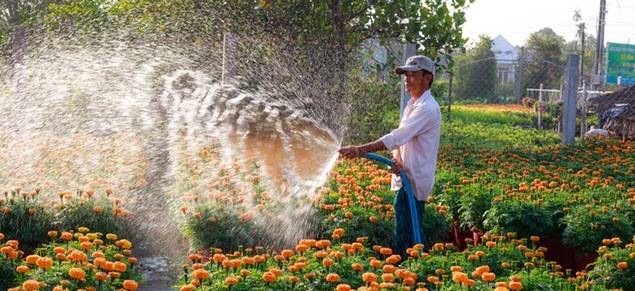Are you looking on ways to solve climate change risks such as floods and droughts and make money while at it? You can promote climate smart agriculture (CSA) to mitigate farmers incomes and yields despite facing droughts and flooding.
Climate smart agriculture methods include irrigation, growing animal fodder and agroforestry among others. Each of these solutions presents you a business solutions as young investor.
In this post, we give you a list of 6 ways you can make money. These most profitable business ideas in climate smart farming are;
- Promote Irrigation
- Formulate animal feeds at home
- Grow animal fodder
- Market climate smart products
- Green house installation services
- Raise tree seedlings for sale
Promote Irrigation
Agriculture in Kenya is rainfed. With frequent drought outbreaks, farmers are losing partial or full crop failure. Irrigation could undo these effects. However, many growers cannot get irrigation kits and efficiently water their crops. The few who can afford usually use ineffective methods which improve soil erosion are inept, pricey and wastewater.
Offering irrigation kits for sale and advice is a rewarding business idea for consideration. Other climate-smart irrigation ideas are;
- supply of solar-powered water pumps.
- Sell and establishment of drip irrigation kits.
- Drilling of boreholes and supply of water tanks
- Promotion of rainwater harvesting technologies such as underground water tanks and water pans.
- Distribution of energy-efficient water pumps and pipes.
Formulate Animal Feeds
The cost of animal feed in the East African region is ridiculously expensive. Sadly, the safety and quality of these animal meals are poor with reports of aflatoxin contamination. The other entrepreneurial idea is the inadequate supply of white maize competitively shared between animal and human consumption.
To solve those challenges, you can process supplement animal feed from the available raw materials. These include the affordable common salt, maize combs, wheat husks, etc. One can concentrate on sourcing/ importing raw materials, formulating, milling and distribution of various animal feeds. To generate more money, concentrate on a variety of feeds and product lines. An excellent animal meal factory can consider distributing pig meal, dairy meal, chicken feed, finishing and fattening formulations, calf pellets, etc.
Grow and sell hay

Occasional droughts have a major effect on the quality and availability of animal meals. Nomadic pastoralists have the opportunity of moving their animals in search of ample food and water from place to place. Private landowners practising intensive dairy farming are most disadvantaged. Those are susceptible to good rain for forage production.
To augment this challenge, one can produce various fodder plants such as grass. Entrepreneurs should produce it in profitable batches. To earn more money, add value through bailing and shipping hay for trade near dairy farmers. Alternatively, source rice, maize and wheat stalks in areas with high production and supply to livestock farmers in fodder scarce areas such as towns at a profit.
Market Climate-smart products and services
Most people would want to source buy and adopt climate-smart technologies to withstand the harsh effects of unfavorable weather. These technologies improve outputs, reduce inputs and are environmentally friendly. Unfortunately, most small-scale farmers lack access to these technologies and information on their usage.
Distributing some of these products and offering services is a good business idea. An example of such is the manufacture of bio-pesticides, repackaging in affordable packages, distribution and training on usage and benefits of the products.
Best ideas in this area include producing organic fertilizers from herbs and animal wastes such as rabbit urine. Making pesticides and herbicides from common farm weeds such as marigold. Breeding, certification and distribution of indigenous crop varieties.
Greenhouse installation services

Protected agriculture involves the use of green and net houses to protect crops from
Insects, wind, frost, extreme temperatures, light intensity, heavy rain, birds and small animals. The crops usually targeted are high-value vegetables such as tomatoes, peppers, potatoes, peas, cabbages, eggplants, cucumbers, berries and stone fruits.
Utilization of protected agriculture in Kenya is low. This makes it a key potential for entrepreneurial exploitation. It can involve entrepreneurs in supplying materials, installing infrastructure, repair and maintenance among other areas.
Raise tree seedlings
Apart from drought, the other hazard effect of global warming is flash flooding. Sometimes they associate with dangerous landslides. We have even made this worse through deforestation to settle or farm. The country wishes to increase forest cover through afforestation and agroforestry. Individuals and institutions are in search of healthy and clean planting seedlings. Venture into this business by running a versatile tree nursery that contains fruit and indigenous trees
Conclusion
Effects of climate change on Kenya’s farming are evident each year. Drought and flooding cycles are becoming constant, long and fierce. These lead to crop failure, inadequate supply of animal feeds and water for irrigation. Their overall effect is food insecurity and poverty.
